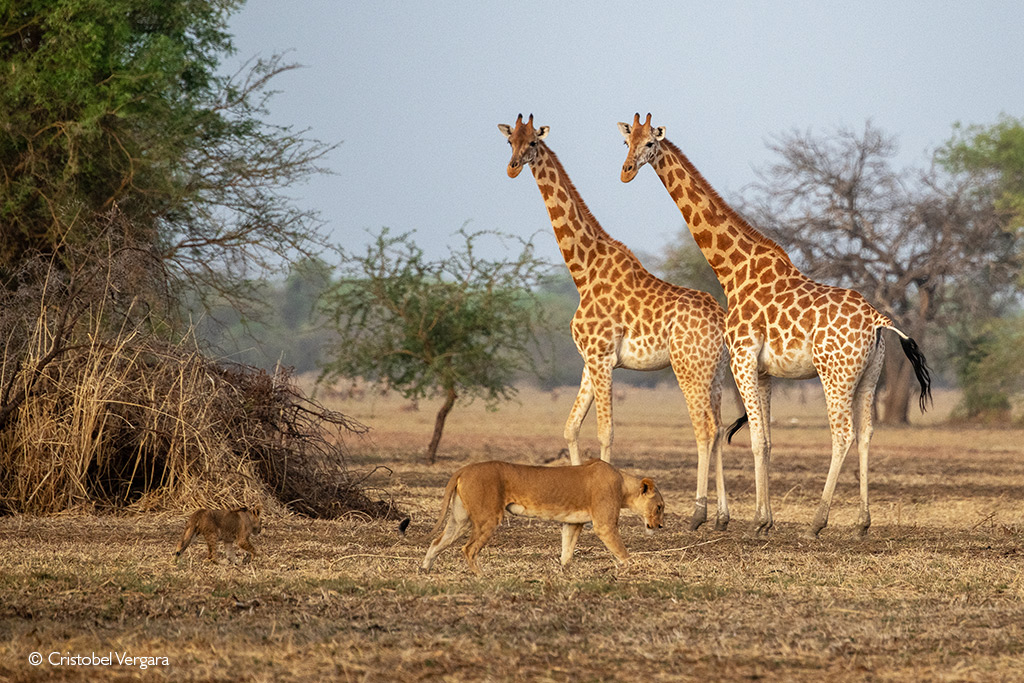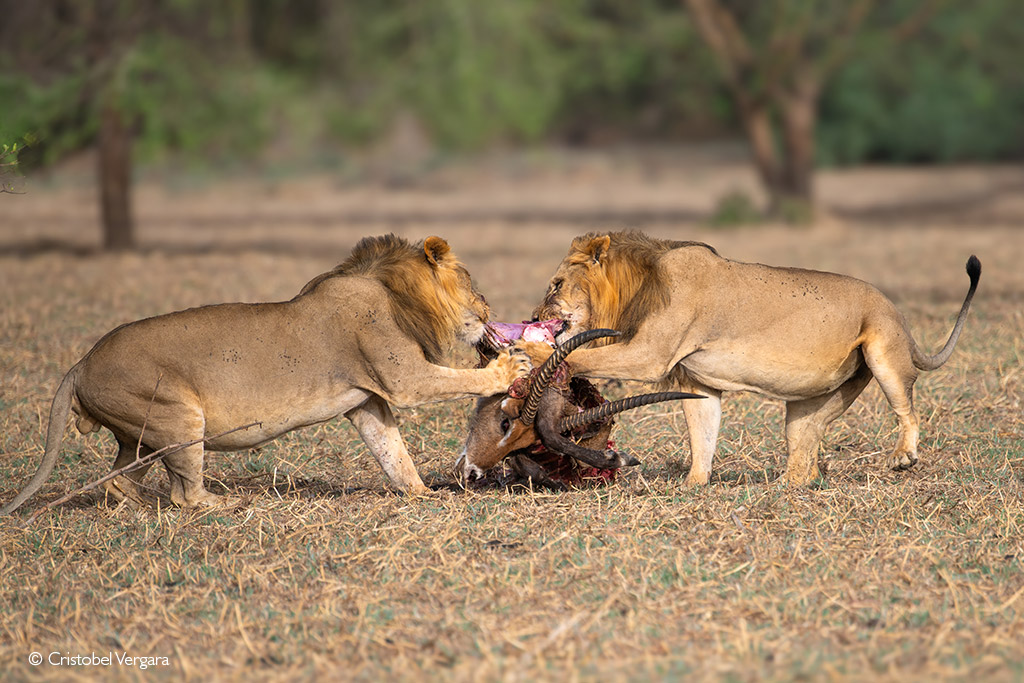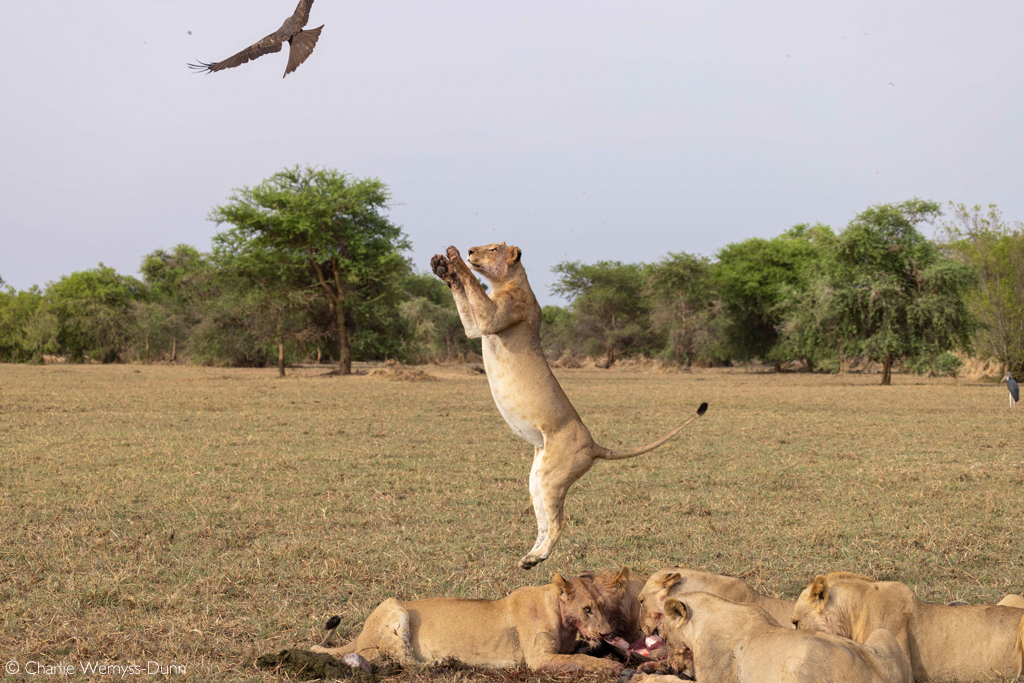
In Chad’s Zakouma National Park, improved conservation efforts have transformed the lions’ menu from small antelope to towering giraffes and hefty buffalo. And that’s not the only thing that’s changing: lions are forming larger prides. Can a well-stocked pantry turn even the fiercest predators into discerning diners? Discover how effective park management is reshaping the dietary preferences of Africa’s apex predator in Central Africa.
What is on the menu for Zakouma National Park’s lions? The answer to this is not as simple as saying, “springbok steaks”. Lions, like many other species, eat what’s available to them. If there is a bigger selection of antelope available, then lions might become more picky and choose the tastiest and most convenient option. Prey availability is a key consideration for maintaining a healthy lion population.
But lion populations are sadly declining, especially so in West and Central Africa, where lions have gone extinct or near-extinct in 61% of the protected areas where they previously occurred. It has been speculated that this decline is due to a lack of prey availability. Lions in West and Central Africa kill on average less large prey compared to southern and East Africa . This, however is explained by the lower numbers of large prey species in these areas. Large mammals in West Africa’s protected areas declined by 85%. In Central Africa the decline of wildlife has accelerated in the last 20 years. Consequently, more lions are taking smaller prey and living in smaller prides.
Compared with lions in West and Central Africa, lions in the South and East African regions eat larger prey. In Southern Africa, lions prefer large, non-mega-herbivore prey (92–632 kg) such as blue wildebeest, gemsbok and buffalo – taking high proportions of these species compared to what is available. But the most taken prey weighs between 40 and 251 kg.


Bearing this typical feeding behaviour in mind, a group of researchers decided to compare the lion preferences in Zakouma National Park (Chad) before and after a change in management. It is the only savannah park in Central Africa where large herbivore biomass has not declined but rather showed an exponential increase for many species in the last decade. In 2010, the Government of Chad signed a public-private partnership agreement with African Parks for the management of Zakouma NP. The budget increased, and the partnership led to improved security, decreased poaching and increased abundance of prey.
 DID YOU KNOW that African Parks offers safari camps (lodges and campsites) where 100% of tourism revenue goes to conservation and local communities? Find out more and book your African Parks safari.
DID YOU KNOW that African Parks offers safari camps (lodges and campsites) where 100% of tourism revenue goes to conservation and local communities? Find out more and book your African Parks safari.
The researchers had data on lion prey preference from 2003 to 2006. During this time, elephant calves were reported as the most frequent carcasses, followed by buffalo, waterbuck and hartebeest, but only waterbuck was significantly preferred. The researchers then conducted a new study using similar methods between January 2010 and June 2023. They collected lion-feeding data through opportunistic observations of lions on kills and GPS clusters from collared lions. They found that the lions were selecting larger (>250 kg) prey species (61% of kills). Buffalos and giraffes were by far the preferred species, comprising 86% of the lion’s diet.
The earlier study found that smaller antelope, like kobs, were killed proportional to availability, whilst, in the recent research, lions mostly avoided them. This contrasts other protected areas of West and Central Africa, where kobs form a large proportion of lion kills and are usually eaten proportionally to availability.
What about the elephant calves that lions were seen eating in the historical study? Elephants are generally not considered typical lion prey species (and instances where this occurs frequently in specific areas are an anomaly). Still, the older study recorded 12 instances of lions feeding on juvenile and sub-adult elephants, while none were recorded in the present study except in a single instance of scavenging. This uncommon behaviour has been observed in other parts of Africa and is speculated to be due to low numbers of ungulate species during migration seasons. Another factor is the vulnerability of dependent calves during low rainfall years when herds need to move longer distances in search of food or as a consequence of poaching.

Zakouma’s lions chose bigger prey when more prey species returned to the park. Lions’ group sizes also increased. In fact, lions’ prey selection in Zakouma NP is now consistent with that of other intact, protected areas, with larger foraging groups hunting larger prey. The conclusion is clear: a healthy, diverse prey population in an adequately protected and resourced reserve leads to fussier, happier lions.

References
Bauer, H., Vanherle, N., Di Silvestre, I., & De Iongh, H. H. (2008). Lion-prey relations in West and Central Africa. Mammalian Biology, 73(1), 70–73. https://doi.org/10.1016/j.mambio.2006.11.006
Fraticelli, C., Zayed, A.A., Leirs, H. & Bauer, H. (2024). Lions select larger prey in a Central African protected area with increasingly effective management. Ecology and Evolution . https://doi.org/10.1002/ece3.70062
Hayward, M. W., & Kerley, G. I. H. (2005). Prey preferences of the lion (Panthera leo). Journal of Zoology, 267(3), 309–322. https://doi.org/10.1017/S0952836905007508
Further reading
- Zakouma – a park returned to vibrant wilderness teeming with life, is a once-in-a-lifetime journey for travellers looking for safari adventure. Read more about travelling to Zakouma National Park, jewel of the Sahel, here.
- A visit to Zakouma, central Africa’s last wildlife stronghold, means going back to old-school, authentic safari values. Read more about a safari to Zakouma here.
- Kingsley Holgate & the Afrika Odyssey expedition are connecting 22 African Parks protected areas. Read about their trip to Zakouma, Chad.
- Africa’s lions are disappearing. New research shows that lion populations across the continent have declined by 75% in just five decades. Read about Africa’s vanishing lions here.
To comment on this story: Login (or sign up) to our app here - it's a troll-free safe place 🙂.![]()






